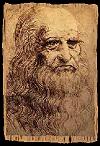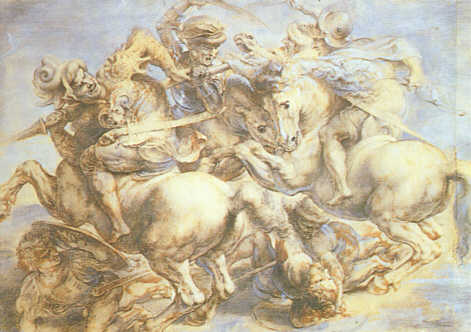|
We all have failures and this potentially magnificent work was one of Leonardo's. The fresco of the Battle of Anghiari was to have been painted in the Council Hall in Florence and stand opposite the Battle of Cascina by Michelangelo. These were events the Florentine Republic saw as worthy of commemoration, Anghiari being a victory over Niccolo Piccinino, the mercenary commander of Milan, and Cascina a victory over Pisa. When finished they would flank the throne of the Gonfaloniere, the chief executive. The up-and-coming Michelangelo (twenty-seven at the time), and the established master, Leonardo, were developing a strong rivalry at this time. They had formed a severe dislike for each other and Leonardo seemed to consider painting alongside Michelangelo as a personal challenge. Michelangelo, for his part, called Leonardo, "the lyre-player from Milan." This was destined to be the battle of the Titans, with a third young artist popping in sometimes to view the progress. The artist was Raphael, who was about 21 at the time.
An ambitious painting, Leonardo used a type of plaster which he read about in a book by Pliny, with the unfortunate result that the work he had barely begun was irreparably ruined. Problems started as soon as Leonardo placed his brush to the wall at 9 am. The weather turned bad, the sky opened and it rained then on until nightfall. The sudden humidity liquefied the paste holding the cartoon in position; as Leonardo lifted his hand to start work the cartoon slid to the floor and tore. An encaustic (translation: 'fixing by heat') technique was that chosen for the artwork. Leonardo took the precaution of doing a trial run of this technique; it was applied to a board and dried well in a warm environment. Firstly a layer of granular plaster was applied, this being primed to a hard flat finish; over this was added a layer of resinous pitch which was applied with sponges. The combination should have supplied a suitable base for the application of oils. During the painting process an ingenious scaffolding was used to raise Leonardo to the needed height for finishing the upper portion of the centre section of this work, but though the scaffolding was a brilliant design, the painting methods chosen were absolutely disastrous. Because of the techniques used the colours refused to dry naturally. In an effort to overcome this a large fire was lit beneath the wall to apply a heat treatment. The upper areas then dried far too hard, while the colours from lower down simply ran and merged; at this point Leonardo gave up. There have been many suggestions as to why this project failed so spectacularly. The master may have been trying to outstrip his younger rival and hurried the process, or the resistance to drying may have been caused either by faulty linseed oil or defective plaster which rejected the colours. What is certain is that Leonardo failed to note an important part of Pliny's instructions which said: "Those among the colours which require a dry, cretaceous, coating, and refuse to adhere to a wet surface, are purpurissum, indicum, caeruleum, milinum, orpiment, appianum, ceruse. Wax, too, is stained with all these colouring substances, for encaustic painting; a process which does not admit of being applied to walls...." Over the next few years what little remained of the painting crumbled so all we have left is eight composition studies, three large studies of heads, a written description, and inaccurate copies done by various artists. Around 1603 Rubens' produced a copy of Leonardo's Battle of Anghiari. Based on an engraving done by Lorenzo Zacchia in 1558, its design has many variations on the original, including the heads of all of the combatants, their weapon styles and their armour or drapery. Yet Reubens achieved something in this painting that no other artist has managed to portray, that is Leonardo's sense of power, confused fury and intense violence. Reuben's Battle of the Standard is sometimes incorrectly portrayed in books, or on the Web, as being the original painting by Leonardo, which it most definitely is not.
One other often overlooked copy of Battle of Anghiari is of interest. This is a drawing done by Rucellai and copied directly from the mural painting itself. Being contemporary with the original work it has great importance because it is as close to an accurate copy as we will ever see. When this drawing was done some parts of Leonardo's mural were unfinished, this can clearly be seen in the sketch where the artist remained faithful to the original work by also leaving his drawing incomplete. Unfortunately Rucellai was not familiar with Leonardo's presentation, so he translated the wall painting in his own style, losing the fiery, intense display from the master. Reubens later recaptured that style, but sacrificed the accuracy. Judging from what remains, the central theme from Leonardo was that of a melee of horses and men interlaced with flames and smoke. In three episodes, the first section showed two fighting men mounted on horseback. The second hexagonal segment gave to this work an alternative title of Battle of the Standard and featured the intense struggle for the colours. Finally we had the cavalry pictured as held in reserve. This was much less than agreed to under the terms of Leonardo's contract which demanded that -- starting from the left -- Niccolo was to be shown issuing strong commands to his men; the Milanese approach in a cloud of dust; St. Peter would then appear to the Patriarch leader of the papal troops who would go to the rescue; the fight for the River Tiber bridge; the arrival of the Patriarch's forces to back up the Florentines; the enemy retreating; the dead buried; the trophy erected. Together these would depict the beginning, middle and end of the battle. Even with an area of 54 ft by 21 ft Leonardo was forced to simplify these demands greatly. The two soldiers to the left are Milanese and it is probable that the one with the upraised sword is Piccinino, the Florentines are then shown charging but St. Peter doesn't put in an appearance anywhere. In the distance is a town with tents which provides the backdrop for fighting soldiers. The section of painting Leonardo did complete shows horses fighting each other with barred teeth, they display terror and aggression. Commissioned in 1503, Leonardo's agreement promised he would complete the work by February 1505 or return all payments. Despite his non-completion and no indication he was making further significant progress, the payments continued after time ran out. The end result was a terse letter regarding his work which was sent from Pier Soderini to Charles d'Amboise. It stated that "Da Vinci has not behaved toward the Republic as he should have, because he accepted a large sum of money and has scarcely begun the great work he was to execute." Leonardo later arranged to leave anyway. It is interesting to note that although there were other pictures commissioned from various artists to mark the Republic's development, none was ever finished. This includes the one by Michelangelo who started work on a full-scale cartoon in 1504 and was then called away to Rome by Pope Julius II. All that remains of his work are copies of the cartoon which showed soldiers being surprised while bathing nude in the Arno. Due to his use of experimental techniques, Leonardo's completed centre section had vanished almost entirely within only fourteen years. Vasari then painted a chaotic battle scene over the area. Ultrasonic tests were carried out in 1976; they searched for traces of Leonardo's painting and none were found. Many, many copies of the Battle of Anghiari have been painted. Each is different, none fully captures the power of original work by Leonardo. Yet another example can be seen, by an unknown artist, in the hi-res images shown below. |
|


